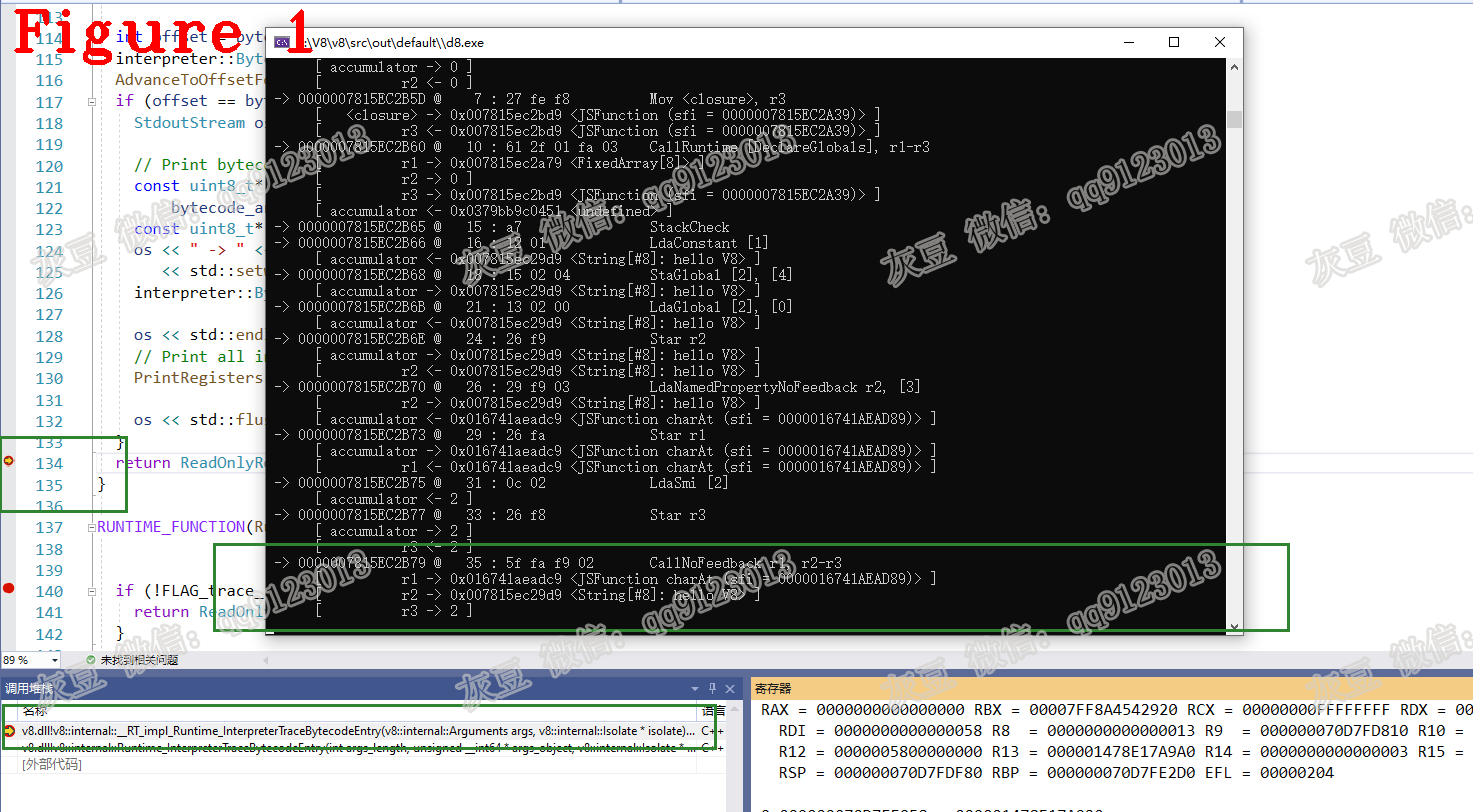《Chrome V8 源码》35. String.prototype.CharAt 源码分析
《Chrome V8 源码》35. String.prototype.CharAt 源码分析

1 介绍
本文先讲解 String.prototype.CharAt 源码以及相关数据结构,再通过测试用例演示 String.prototype.CharAt 的调用、加载和执行过程。
注意 (1)Sea of Nodes 是本文的先导知识,请参考 Cliff 1993年发表的论文 From Quads to Graphs。(2)本文所用环境为:V8 7.9、win10 x64、VS2019。
本文的测试用例如下:
1. var s = "hello V8";
2. var c = s.charAt(2);
3. console.log(c);
2 CharAt 源码
String.prototype.CharAt 由 TF_Bultin 实现,编号是 885。String.prototype.CharAt 源码中使用了TF_BUILTIN宏模板,宏模板展开后的源码如下:
1. class StringPrototypeCharAtAssembler : public CodeStubAssembler {
2. public:
3. using Descriptor = Builtin_StringPrototypeCharAt_InterfaceDescriptor;
4. explicit StringPrototypeCharAtAssembler(compiler::CodeAssemblerState* state)
5. : CodeStubAssembler(state) {}
6. void GenerateStringPrototypeCharAtImpl();
7. Node* Parameter(Descriptor::ParameterIndices index) {/*省略*/ }
8. };
9. void Builtins::Generate_StringPrototypeCharAt(compiler::CodeAssemblerState* state) {
10. StringPrototypeCharAtAssembler assembler(state);
11. //省略.....
12. assembler.GenerateStringPrototypeCharAtImpl();
13. }
14. void StringPrototypeCharAtAssembler::GenerateStringPrototypeCharAtImpl(){
15. //省略.....
16. if (block0.is_used()) {
17. compiler::TNode<Context> tmp0;
18. compiler::TNode<Object> tmp1;
19. compiler::TNode<Object> tmp2;
20. ca_.Bind(&block0, &tmp0, &tmp1, &tmp2);
21. ca_.SetSourcePosition("../../../src/builtins/string.tq", 77);
22. compiler::TypedCodeAssemblerVariable<String> result_0_0(&ca_);
23. compiler::TypedCodeAssemblerVariable<IntPtrT> result_0_1(&ca_);
24. compiler::TypedCodeAssemblerVariable<IntPtrT> result_0_2(&ca_);
25. compiler::CodeAssemblerLabel label0(&ca_);
26. compiler::CodeAssemblerLabel label1(&ca_);
27. GenerateStringAt_336(state_, compiler::TNode<Context>{tmp0}, compiler::TNode<Object>{tmp1}, compiler::TNode<Object>{tmp2}, "String.prototype.charAt", &label0, &result_0_0, &result_0_1, &result_0_2, &label1);
28. if (label0.is_used()) {
29. ca_.Bind(&label0);
30. ca_.Goto(&block5, tmp0, tmp1, tmp2, tmp1, tmp2, result_0_0.value(), result_0_1.value(), result_0_2.value());
31. } }
32. if (block5.is_used()) {
33. //省略.....
34. ca_.Bind(&block5, &tmp3, &tmp4, &tmp5, &tmp6, &tmp7, &tmp8, &tmp9, &tmp10);
35. ca_.Goto(&block4, tmp3, tmp4, tmp5, tmp8, tmp9, tmp10);
36. }
37. if (block4.is_used()) {
38. //省略.....
39. ca_.Bind(&block4, &tmp16, &tmp17, &tmp18, &tmp19, &tmp20, &tmp21);
40. ca_.SetSourcePosition("../../../src/builtins/string.tq", 81);
41. compiler::TNode<Int32T> tmp22;
42. USE(tmp22);
43. tmp22 = CodeStubAssembler(state_).StringCharCodeAt(compiler::TNode<String>{tmp19}, compiler::TNode<IntPtrT>{tmp20});
44. ca_.SetSourcePosition("../../../src/builtins/string.tq", 82);
45. compiler::TNode<String> tmp23;
46. USE(tmp23);
47. tmp23 = CodeStubAssembler(state_).StringFromSingleCharCode(compiler::TNode<Int32T>{tmp22});
48. CodeStubAssembler(state_).Return(tmp23);
49. }}
编译 String.prototype.CharAt 时,先调用 Builtins::GenerateStringPrototypeCharAt() 方法(第 9 行)生成中间结果,然后 compiler::CodeAssembler::GenerateCode() 方法再将中间结果编译成二进制代码并存储在 butiltin 数组中。 StringPrototypeCharAtAssembler::GenerateStringPrototypeCharAtImpl() (第 14 行)的关键功能如下:
(1) 第 18 行代码 tmp1 代表测试用例中的字符串 “hello V8”;
(2) 第 19 行代码 tmp2 代表测试用例中的 position, position 的值为 2;
(3) 第 27 行代码 GenerateStringAt_336() 判断 tmp1 的类型是否为 string 且 tmp2 是否小于 tmp1 的长度,判断结果为真则执行 32 行代码;
(4) 第 34-35 行代码绑定参数,跳转到第 37 行;
(5) 第 40-43 行代码调用 StringCharCodeAt() 获取指定位置的字符(tmp2)并存储在 tmp22 中。使用 StringFromSingleCharCode() 方法把 tmp22 转换为最终结果,并在第 48 行返回此结果。至此,CharAt 执行完毕。
下面说明 GenerateStringPrototypeCharAtImpl 用到的几个重要方法。
(1) GenerateStringAt_336() 判断字符串的类型和参数的长度是否正确,源码如下:
1. void GenerateStringAt_336(/*省略*/) {
2. ca_.Goto(&block0, p_context, p_receiver, p_position);
3. //省略........
4. if (block0.is_used()) {
5. ca_.Bind(&block0, &tmp0, &tmp1, &tmp2);
6. compiler::TNode<String> tmp4;
7. USE(tmp4);
8. tmp4 = CodeStubAssembler(state_).ToThisString(compiler::TNode<Context>{tmp0}, compiler::TNode<Object>{tmp1}, compiler::TNode<String>{tmp3});
9. ca_.SetSourcePosition("../../../src/builtins/string.tq", 65);
10. compiler::TNode<Number> tmp5;
11. USE(tmp5);
12. tmp5 = CodeStubAssembler(state_).ToInteger_Inline(compiler::TNode<Context>{tmp0}, compiler::TNode<Object>{tmp2}, CodeStubAssembler::ToIntegerTruncationMode::kTruncateMinusZero);
13. ca_.SetSourcePosition("../../../src/builtins/string.tq", 64);
14. ca_.SetSourcePosition("../../../src/builtins/string.tq", 66);
15. compiler::TNode<BoolT> tmp6;
16. USE(tmp6);
17. tmp6 = CodeStubAssembler(state_).TaggedIsNotSmi(compiler::TNode<Object>{tmp5});
18. ca_.Branch(tmp6, &block3, &block4, tmp0, tmp1, tmp2, tmp4, tmp5);
19. }//省略........
20. if (block4.is_used()) {
21. //省略...........
22. ca_.Branch(tmp22, &block5, &block6, tmp12, tmp13, tmp14, tmp15, tmp16, tmp18, tmp19);
23. }
24. if (block6.is_used()) {ca_.Goto(&block1, tmp33, tmp35, tmp36);}
25. if (block1.is_used()) {ca_.Goto(label_IfInBounds);}
26. if (block2.is_used()) {
27. ca_.Bind(&block2);
28. ca_.Goto(label_IfOutOfBounds);} }
上述代码中,第 8 行 把 this(测试用例中的字符串)的类型转换为字符串;
第 9-12 行代码判断 position 的长度(测试用例中的 2)是否需要截断;
第 17 行代码判断 position 的长度是否符合规定,判断结果存储在 tmp6 中;
第 18 行代码会根据 tmp6 的结果进行跳转,若结果为真则跳转到 block4;
第 21 行代码判断 position 是否小于字符串的长度,小于代表 CharAt() 操作没有越界(InBound),否则代表 OutBound,OutBound 意味着最终的结果为空。
(2) StringCharCodeAt() 定义在类 CodeStubAssembler 中,源码如下:
1. TNode<Int32T> CodeStubAssembler::StringCharCodeAt(SloppyTNode<String> string,
2. SloppyTNode<IntPtrT> index) {
3. CSA_ASSERT(this, IsString(string));
4. CSA_ASSERT(this, IntPtrGreaterThanOrEqual(index, IntPtrConstant(0)));
5. CSA_ASSERT(this, IntPtrLessThan(index, LoadStringLengthAsWord(string)));
6. TVARIABLE(Int32T, var_result);
7. Label return_result(this), if_runtime(this, Label::kDeferred),
8. if_stringistwobyte(this), if_stringisonebyte(this);
9. ToDirectStringAssembler to_direct(state(), string);
10. to_direct.TryToDirect(&if_runtime);
11. TNode<IntPtrT> const offset = IntPtrAdd(index, to_direct.offset());
12. TNode<Int32T> const instance_type = to_direct.instance_type();
13. TNode<RawPtrT> const string_data = to_direct.PointerToData(&if_runtime);
14. // Check if the {string} is a TwoByteSeqString or a OneByteSeqString.
15. Branch(IsOneByteStringInstanceType(instance_type), &if_stringisonebyte,
16. &if_stringistwobyte);
17. BIND(&if_stringisonebyte);
18. {
19. var_result =
20. UncheckedCast<Int32T>(Load(MachineType::Uint8(), string_data, offset));
21. Goto(&return_result);
22. }
23. BIND(&if_stringistwobyte);
24. {
25. var_result =
26. UncheckedCast<Int32T>(Load(MachineType::Uint16(), string_data,
27. WordShl(offset, IntPtrConstant(1))));
28. Goto(&return_result);
29. }
30. BIND(&if_runtime);
31. {
32. TNode<Object> result = CallRuntime(
33. Runtime::kStringCharCodeAt, NoContextConstant(), string, SmiTag(index));
34. var_result = SmiToInt32(CAST(result));
35. Goto(&return_result);
36. }
37. BIND(&return_result);
38. return var_result.value();
39. }
上述代码中,第 2-5 行判断字符串类型是否正确、index 是否大于等于零且小于字符串长度;
第 6 行代码申请 Int32 类型的变量 var_result,用于存储返回值;
第 7 行代码申请四个标签变量,将来该变量会配合 Branch 完成函数跳转;
第 10 行代码 to_direct.TryToDirect(&if_runtime) 的作用是将 flat、thin 或 slice 类型的 indirect string 转换成 direct string。若转换失败则跳转到第 30 行代码,使用 runtime 处理字符串;若转换成功则返回到 string_data;
第 15 行代码判断字符串类型是单字节还是双字节;
第 19 行代码使用单字节方式从 string_data 的偏移位置读取字节并存储到 var_result 中;
第 25 行代码使用双字节方式从 string_data 的偏移位置读取字节并存储到 var_result中;
第 32 行代码使用 runtime 方式实现 StringChartAt 功能,后续文章另做讲解。
(3) StringFromSingleCharCode() 定义在 CodeStubAssembler 中,作用是把 Int 数值转换为字符串。
3 CharAt 测试
测试代码的字节码如下:
1. //分隔线............//省略了部分字节码
2. 8 S> 0000012A281C2B26 @ 16 : 12 01 LdaConstant [1]
3. 8 E> 0000012A281C2B28 @ 18 : 15 02 04 StaGlobal [2], [4]
4. 29 S> 0000012A281C2B2B @ 21 : 13 02 00 LdaGlobal [2], [0]
5. 0000012A281C2B2E @ 24 : 26 f9 Star r2
6. 31 E> 0000012A281C2B30 @ 26 : 29 f9 03 LdaNamedPropertyNoFeedback r2, [3]
7. 0000012A281C2B33 @ 29 : 26 fa Star r1
8. 0000012A281C2B35 @ 31 : 0c 02 LdaSmi [2]
9. 0000012A281C2B37 @ 33 : 26 f8 Star r3
10. 31 E> 0000012A281C2B39 @ 35 : 5f fa f9 02 CallNoFeedback r1, r2-r3
11. 29 E> 0000012A281C2B3D @ 39 : 15 04 06 StaGlobal [4], [6]
12. 43 S> 0000012A281C2B40 @ 42 : 13 05 08 LdaGlobal [5], [8]
13. 0000012A281C2B43 @ 45 : 26 f9 Star r2
14. 51 E> 0000012A281C2B45 @ 47 : 29 f9 06 LdaNamedPropertyNoFeedback r2, [6]
15. 0000012A281C2B48 @ 50 : 26 fa Star r1
16. 55 E> 0000012A281C2B4A @ 52 : 13 04 02 LdaGlobal [4], [2]
17. 0000012A281C2B4D @ 55 : 26 f8 Star r3
18. 51 E> 0000012A281C2B4F @ 57 : 5f fa f9 02 CallNoFeedback r1, r2-r3
19. 0000012A281C2B53 @ 61 : 26 fb Star r0
20. 58 S> 0000012A281C2B55 @ 63 : ab Return
21. Constant pool (size = 7)
22. 0000012A281C2A99: [FixedArray] in OldSpace
23. - map: 0x0148906c0169 <Map>
24. - length: 7
25. 0: 0x012a281c2a39 <FixedArray[8]>
26. 1: 0x012a281c2999 <String[#8]: hello V8>
27. 2: 0x012a281c2981 <String[#1]: s>
28. 3: 0x00024f52ad19 <String[#6]: charAt>
29. 4: 0x00024f53e069 <String[#1]: c>
30. 5: 0x00024f533699 <String[#7]: console>
31. 6: 0x00024f532cd9 <String[#3]: log>
上述代码中,第 2 行代码把常量 hello v8 加载到累加寄存器;第 3-5 行代码存储并读取常量 hello v8 ,该常量最终被存储到 r2 寄存器中;第 6 行代码加载 String.prototype.CharAt(),第 10 行代码调用 String.prototype.CharAt;第 25-31 行是常量池,用于存储运行期间需要使用的常量。

调试字节码 CallNoFeedback 的执行可以看到 String.prototype.CharAt 的执行过程。调试方法为:设置 FLAG_trace_ignition = true;在 Runtime_InterpreterTraceBytecodeEntry 中设置断点;在图 1 中的 “CallNoFeedback r1, r2-r3” 位置使用汇编进行调试。
技术总结
(1) 编译 String.prototype.CharAt 生成的二进制代码(code)存放在 builtin_ 数组中,解释执行 JavaScript 源码时会使用 code,而不是使用本文所讲的 StringCharAt 的源码;
(2) V8 中字符串细分为单字节、双字节、flat 等类型;
(3) indirect 类型的字符串只能使用 runtime 处理,先用 to_direct.TryToDirect() 判断字符串类型可以省去 runtime 不必要的操作;
(4) String.prototype.CharAt 的工作流程是:判断字符串类型和位置是否正确、判断位置是否越界、直接字符串采用 Builtin 方式处理、间接字符串采用 runtime 方式处理。
好了,今天到这里,下次见。
个人能力有限,有不足与纰漏,欢迎批评指正
微信:qq9123013 备注:v8交流 邮箱:v8blink@outlook.com
